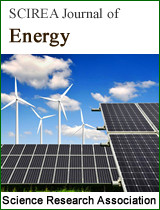Effect of POCl3 bubbler temperature on solar cells emitter characteristics
DOI: 386 Downloads 15962 Views
Author(s)
Abstract
The effect of POCl3 bubbler temperature on silicon n+/p solar cells emitter characteristics is investigated in this paper. By increasing the bubbler temperature, calculations and secondary ion mass spectroscopy characterization showed that the amount of phosphorus entering the diffusion tube has significantly increased. On the contrary, emitter sheet resistances remain constant. This was confirmed and explained by emitters depth profiling of the electrically active phosphorus. Besides that, the minority carrier lifetime measured by means of Quasi-Steady-State Photoconductance technique decreased indicating that the excess of phosphorus deposited on emitter surface degrades the emitter electrical performance. The same trend has been observed for the implied open circuit voltage. It decreased from 632 mV at 15°C to 602 mV at 26°C. In conclusion, we have shown that the temperature of the POCl3 bubbler is also an important parameter that controls the emitter properties.
Keywords
Silicon, Diffusion, POCl3.
Cite this paper
A. El Amrani, Y. Boudiaf, A. Saibi, L. Mahiou,
Effect of POCl3 bubbler temperature on solar cells emitter characteristics
, SCIREA Journal of Energy.
Volume 1, Issue 2, December 2016 | PP. 60-70.
References
| [ 1 ] | D. Nobili, A. Armigliato, M. Finetti and S. Solmi, J. Appl. Phys. 53(3), 1484 (1982). |
| [ 2 ] | S. Solmi, D. Nobili, J. Appl. Phys. 83 (5), 2484(1998). |
| [ 3 ] | O. Velichko, V. Dobrushkin, L. Pakula, Mat Sci Eng B-solid 123 (2), 176 (2005). |
| [ 4 ] | A. Richter, F. Werner, A. Cuevas, J. Schmidt, S.W. Glunz, Energy Procedia 27, 88 (2012). |
| [ 5 ] | H. Jun Lee et al., Curr. Appl. Phys. 13, 1718 (2013). |
| [ 6 ] | S. Graf, J. Junge, S. Seren, and G. Hahn, in Proceedings of 25th European Photovoltaic Solar Energy Conference, Valencia ( Spain) , 2010, p. 1770. |
| [ 7 ] | Process Guidelines for Using Phosphorous Oxychloride as an N-Type Silicon Dopant. Air Products and Chemicals, http://www.airproducts.com/products/Chemicals/Specialty- Chemicals-Electronics/Doping.aspx, 2016 (accessed 13 03 16). |
| [ 8 ] | Stull, Daniel R., Ind. Eng. Chem. 39 (4), 517 (1947). |
| [ 9 ] | B.C. Chakravarty, P.N. Vinod, S.N. Singh, B.R. Chakraborty, Sol Energ Mat Sol C 73, 596 (2002). |
| [ 10 ] | S. Wolf and R. N. Tauber, Silicon Processing for the VLSI, Volume 1: Process Technology (Lattice Press, Sunset Beach, California, 1987). |

